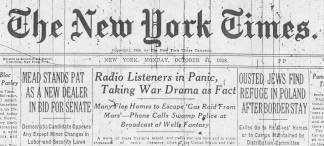Martians Invade New Jersey
The famed radio broadcast of HG Wells' War of the Worlds took place on October 30th, 1938.
 The headline in The New York Times was ‘Radio Listeners in Panic, Taking War Drama as Fact’. The ‘Mercury Theatre of the Air’, which was an offshoot of President Franklin Roosevelt’s New Deal and had a free hour once a week on the CBS radio network, had put on a special version for Hallowe’en of H.G.Wells’ The War of the Worlds. The script was mainly by Howard Koch of the Mercury Theatre’s writing team, who privately thought the 1898 book dated and dull, and directed by the young, up-and-coming Orson Welles.
The headline in The New York Times was ‘Radio Listeners in Panic, Taking War Drama as Fact’. The ‘Mercury Theatre of the Air’, which was an offshoot of President Franklin Roosevelt’s New Deal and had a free hour once a week on the CBS radio network, had put on a special version for Hallowe’en of H.G.Wells’ The War of the Worlds. The script was mainly by Howard Koch of the Mercury Theatre’s writing team, who privately thought the 1898 book dated and dull, and directed by the young, up-and-coming Orson Welles.
The original story was about a Martian invasion of England, but Koch moved the scene to a village in New Jersey. The fact that the broadcast was not interrupted by commercials helped to lend it authenticity. It started with what seemed to be a conventional dance music programme, which was interrupted by increasingly alarming news bulletins leading up to a report of a meteorite landing in New Jersey. The meteorite turned out to be a Martian rocket, whose occupants mowed down villagers and state troopers with heat-rays that left their bodies horribly burned and distorted. The aliens were described in craftily vague but terrifying terms.
More Martian landings were reported, with spacecraft spraying poison gas and destroying railroads, power lines and bridges. An anonymous politician, who managed to sound very like President Roosevelt, came on to say that the nation must confront ‘this destructive adversary’ and a fictitious Princeton University professor, played by Welles himself, solemnly pronounced that the death-rays were projected by ‘a polished parabolic mirror of unknown composition’. Listeners heard apparently factual reports of American troops vainly attacking the Martians as they headed for New York City and a news reporter described monstrous machines stalking across the Hudson River, with poisonous smoke drifting across the city and people ‘falling like flies’ or diving into the East River ‘like rats’. Then the reporter himself fell victim to the poison gas and all that could be heard was a ham radio operator saying plaintively, ‘2X2L calling CQ … Isn’t there anyone on the air? Isn’t there anyone on the air? Isn’t there anyone?’
Like the original novel, the story ended with the Martians falling victims to earthly bacteria, and then Welles came on as himself to announce that it had all been a fantasy for Hallowe’en. Meanwhile, there were reports of listeners hurrying hysterically to their neighbours, fleeing their homes in terror with wet towels over their heads as improvised gas masks, rushing to church, giving birth to premature babies. The CBS control room was deluged with frightened phone calls. The programme was fiercely criticized for causing the panic, which was itself exaggerated by the newspapers, but the broadcast made Orson Welles’ name at the age of twenty-three.




